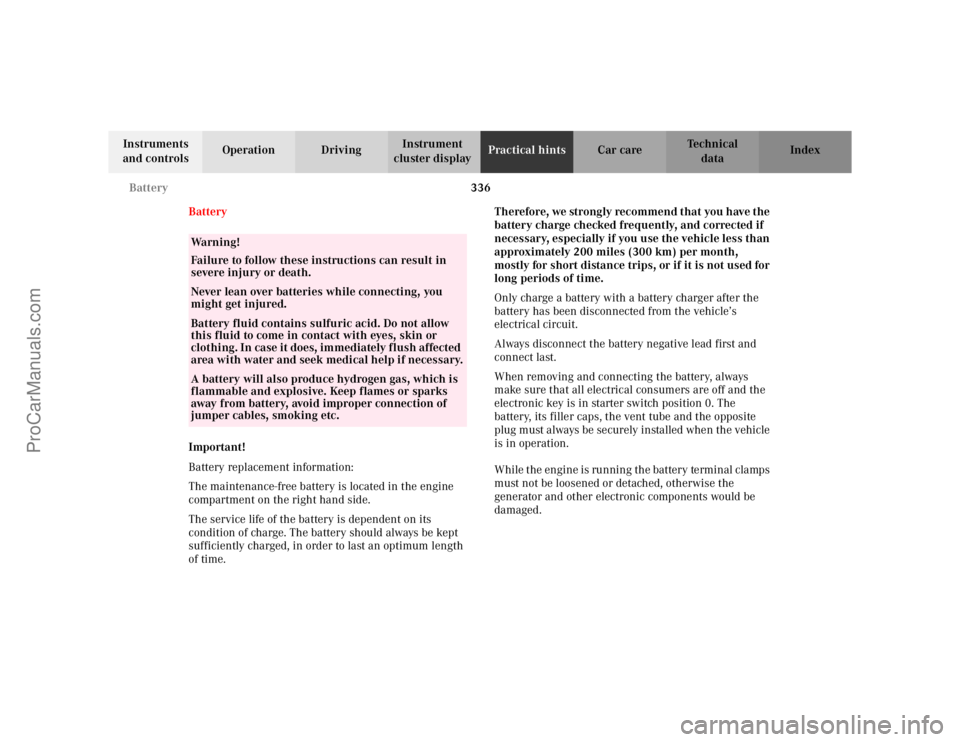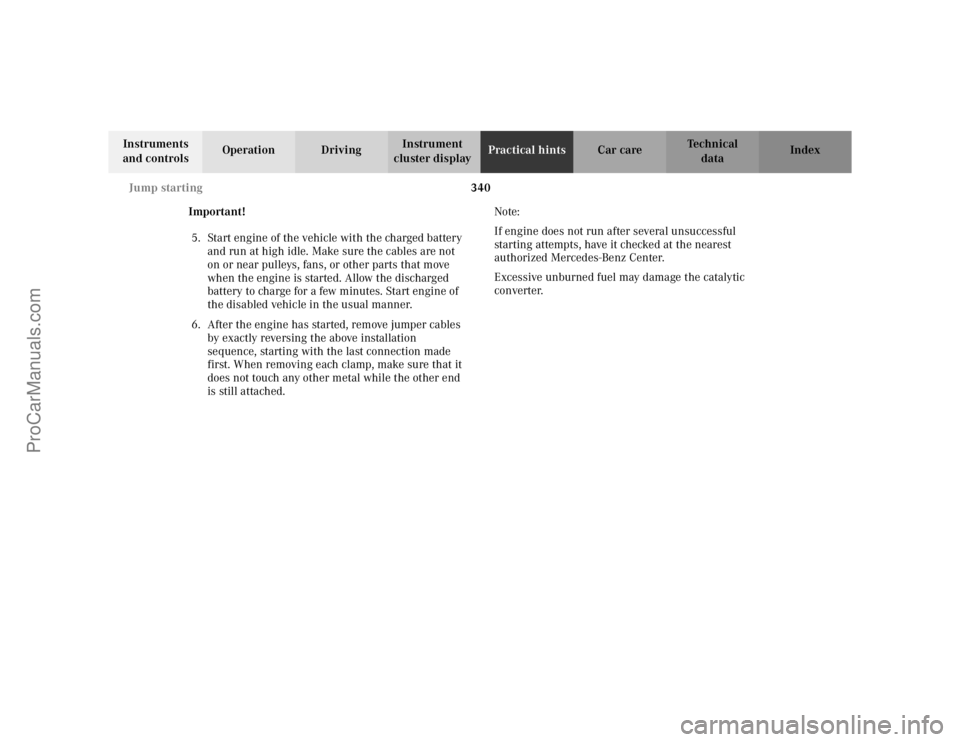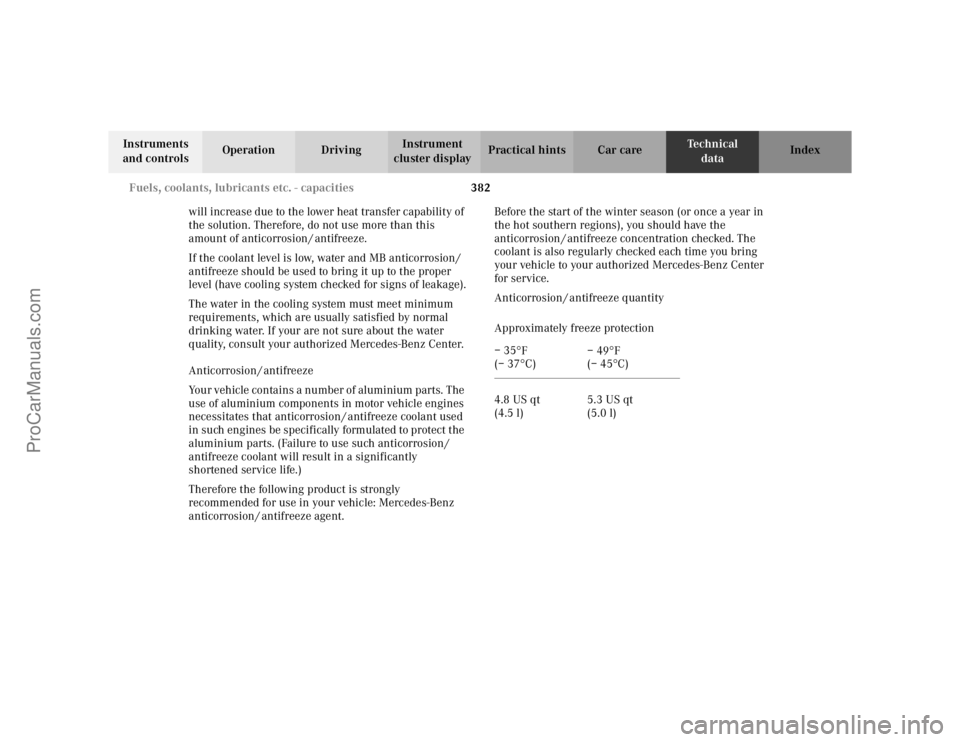check engine MERCEDES-BENZ C-CLASS 2002 Owner's Guide
[x] Cancel search | Manufacturer: MERCEDES-BENZ, Model Year: 2002, Model line: C-CLASS, Model: MERCEDES-BENZ C-CLASS 2002Pages: 399, PDF Size: 16.95 MB
Page 322 of 399

319
Engine compartment
Te ch n i c a l
data
Instruments
and controls Operation Driving
Instrument
cluster display Practical hints
Car care Index
Coolant level
1 Coolant expansion tank
To check the coolant level, the vehicle must be parked
on level ground an d the engine stopped.
Check coolant level only when coolant is cold.
The coolant level should reach the black top part of the
reservoir.
See page 381 for antifreeze / anticorrosion mixture. Adding coolant
If coolant has to be added, a 50/50 mixture of water and
MB anticorrosion / antifreeze should be added.
Wa r n i n g !
• In order to avoid possibly serious burns: Use extreme caution when opening the hood if
there are any signs of steam or coolant leaking
from the cooling system, or if the coolant
temperature gauge indicates that the coolant is
overheated.• Do not remove pressure cap on coolant
reservoir if engine temperature is above 194
°F
(90
°C). Allow engine to cool down before
removing cap. The coolant reservoir contains
hot fluid and is under pressure.
• Using a rag, slowly open cap approximately
1/2 turn to relieve excess pressure. If opened
immediately, scalding hot fluid and steam will
be blown out under pressure.• Do not spill antifreeze on hot engine parts. Antifreeze contains ethylene glycol which may
burn if it comes into contact with hot engine
parts.
ProCarManuals.com
Page 339 of 399

336
Battery
Te ch n i c a l
data
Instruments
and controls Operation Driving
Instrument
cluster display Practical hints
Car care Index
Battery
Important!
Battery replacement information:
The maintenance-free battery is located in the engine
compartment on the right hand side.
The service life of the battery is dependent on its
condition of charge. The battery should always be kept
sufficiently charged, in order to last an optimum length
of time. Therefore, we strongly recommend that you have the
battery charge checked frequently, and corrected if
necessary, especially if you use the vehicle less than
approximately 200 miles (300 km) per month,
mostly for short distance trips, or if it is not used for
long periods of time.
Only charge a battery with a battery charger after the
battery has been disconnected from the vehicle’s
electrical circuit.
Always disconnect the battery negative lead first and
connect last.
When removing and connecting the battery, always
make sure that all electrical consumers are off and the
electronic key is in starter switch position 0. The
battery, its filler caps, the vent tube and the opposite
plug must always be securely installed when the vehicle
is in operation.
While the engine is running the battery terminal clamps
must not be loosened or detached, otherwise the
generator and other electronic components would be
damaged.
Wa r n i n g !
Failure to follow these instructions can result in
severe injury or death.Never lean over batteries while connecting, you
might get injured.Battery fluid contains sulfuric acid. Do not allow
this fluid to come in contact with eyes, skin or
clothing. In case it does, immediately flush affected
area with water and seek medical help if necessary.A battery will also produce hydrogen gas, which is
flammable and explosive. Keep flames or sparks
away from battery, avoid improper connection of
jumper cables, smoking etc.
ProCarManuals.com
Page 343 of 399

340
Jump starting
Te ch n i c a l
data
Instruments
and controls Operation Driving
Instrument
cluster display Practical hints
Car care Index
Important! 5. Start engine of the vehicle with the charged battery and run at high idle. Make sure the cables are not
on or near pulleys, fans, or other parts that move
when the engine is started. Allow the discharged
battery to charge for a few minutes. Start engine of
the disabled vehicle in the usual manner.
6. After the engine has started, remove jumper cables by exactly reversing the above installation
sequence, starting with the last connection made
first. When removing each clamp, make sure that it
does not touch any other metal while the other end
is still attached. Note:
If engine does not run after several unsuccessful
starting attempts, have it checked at the nearest
authorized Mercedes-Benz Center.
Excessive unburned fuel may damage the catalytic
converter.
ProCarManuals.com
Page 385 of 399

382
Fuels, coolants, lubricants etc. - capacities
Te ch n i c a l
data
Instruments
and controls Operation Driving
Instrument
cluster display Practical hints Car care Index
will increase due to the lower heat transfer capability of
the solution. Therefore, do not use more than this
amount of anticorrosion / antifreeze.
If the coolant level is low, water and MB anticorrosion /
antifreeze should be used to bring it up to the proper
level (have cooling system checked for signs of leakage).
The water in the cooling system must meet minimum
requirements, which are usually satisfied by normal
drinking water. If your are not sure about the water
quality, consult your authorized Mercedes-Benz Center.
Anticorrosion / antifreeze
Your vehicle contains a number of aluminium parts. The
use of aluminium components in motor vehicle engines
necessitates that anticorrosion / antifreeze coolant used
in such engines be specifically formulated to protect the
aluminium parts. (Failure to use such anticorrosion /
antifreeze coolant will result in a significantly
shortened service life.)
Therefore the following product is strongly
recommended for use in your vehicle: Mercedes-Benz
anticorrosion / antifreeze agent. Before the start of the winter season (or once a year in
the hot southern regions), you should have the
anticorrosion / antifreeze concentration checked. The
coolant is also regularly checked each time you bring
your vehicle to your authorized Mercedes-Benz Center
for service.
Anticorrosion / antifreeze quantity
Approximately freeze protection
– 35
°F
(– 37°C) – 49
°F
(– 45°C)
4.8 US qt
(4.5 l) 5.3 US qt
(5.0 l)
ProCarManuals.com
Page 389 of 399

386
Index
Te ch n i c a l
data
Instruments
and controls Operation Driving
Instrument
cluster display Practical hints Car care
Index
BBabySmart
TM airbag deactivation system..................... 69
Battery ............................................................................. 336
Block heater .................................................................... 266
Brake assist system (BAS) ............................................ 271
Bulbs See Replacing bulbs ................................................. 345
CCD changer installed ..................................................... 187
Cellular telephone ......................................................... 219
Center console .................................................................. 24
Central locking switch .................................................... 38
Central locking system ................................................... 31Automatic central locking ......................................... 40
Central locking switch ............................................... 38
Choosing global or selective mode........................... 33
Doors ............................................................................. 36
General notes............................................................... 30
Locking and unlocking with remote control .......... 33
Mechanical keys .......................................................... 35
Obtaining replacement keys ..................................... 29
Summer opening/convenience feature ................... 34 Vehicle keys ................................................................. 28
Changing wheels........................................................... 327 Inflating the collapsible spare tire ........................ 333
Storing spare wheel in wheel well ........................ 334
Check regularly and before a long trip...................... 280
Child seat See Infant and child restraint systems .................... 82
Climate control ............................................................... 152 Adjustable air outlets, rear passenger compartment ......................................................... 172
Air recirculation ........................................................ 158
Basic setting............................................................... 156
Defrosting ................................................................... 157
Display and controls ................................................. 154
Dust filter.................................................................... 155
Economy mode .......................................................... 159
Front center console storage compartment ventilation ............................................................. 171
Residual engine heat utilization ............................. 159
Special settings ......................................................... 156
Windows fogged up on the inside .......................... 157
Windows fogged up on the outside ................ 157, 166
COMAND, radio and telephone................................... 226
Combination switch ....................................................... 148
Control and operation of radio transmitters ............. 226
Coolant level ................................................................... 319
ProCarManuals.com